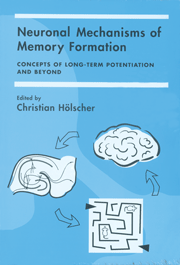Book contents
- Frontmatter
- Contents
- Contributors
- Introduction: Long-Term Potentiation as a Model for Memory Mechanisms: The Story So Far
- Section One Long-Term Potentiation In Vitro and In Vivo: How Can We Fine-Tune the Current Models for Memory Formation?
- Section Two There is More to the Picture Than Long-Term Potentiation: Theta or Gamma Oscillations in the Brain and the Facilitation of Synaptic Plasticity
- 5 Synaptic Potentiation by Natural Patterns of Activity in the Hippocampus: Implications for Memory Formation
- 6 Plasticity in Local Neuronal Circuits: In Vivo Evidence from Rat Hippocampus and Amygdala
- 7 Theta-Facilitated Induction of Long-Term Potentiation: A Better Model for Memory Formation?
- 8 Role of Gamma Oscillations for Information Processing and Memory Formation in the Neocortex
- Section Three Making Models from Empirical Data of Synaptic Plasticity
- Section Four Setting the Stage for Memory Formation: Stress, Arousal, and Attention
- Section Five Transgenic Mice as Tools to Unravel the Mechanisms of Memory Formation
- Conclusions and Future Targets
- Index
6 - Plasticity in Local Neuronal Circuits: In Vivo Evidence from Rat Hippocampus and Amygdala
Published online by Cambridge University Press: 13 October 2009
- Frontmatter
- Contents
- Contributors
- Introduction: Long-Term Potentiation as a Model for Memory Mechanisms: The Story So Far
- Section One Long-Term Potentiation In Vitro and In Vivo: How Can We Fine-Tune the Current Models for Memory Formation?
- Section Two There is More to the Picture Than Long-Term Potentiation: Theta or Gamma Oscillations in the Brain and the Facilitation of Synaptic Plasticity
- 5 Synaptic Potentiation by Natural Patterns of Activity in the Hippocampus: Implications for Memory Formation
- 6 Plasticity in Local Neuronal Circuits: In Vivo Evidence from Rat Hippocampus and Amygdala
- 7 Theta-Facilitated Induction of Long-Term Potentiation: A Better Model for Memory Formation?
- 8 Role of Gamma Oscillations for Information Processing and Memory Formation in the Neocortex
- Section Three Making Models from Empirical Data of Synaptic Plasticity
- Section Four Setting the Stage for Memory Formation: Stress, Arousal, and Attention
- Section Five Transgenic Mice as Tools to Unravel the Mechanisms of Memory Formation
- Conclusions and Future Targets
- Index
Summary
SUMMARY
At present, long-term potentiation (LTP) of synaptic transmission is the leading neurophysiologic model for learning and memory processes, despite controversial results regarding its behavioral correlates. The evidence we present in this chapter demonstrates lasting plasticity at the level of local neuronal assemblies in both hippocampus and amygdala. Local circuit plasticity (LCP) is induced by tetanic stimulation of afferent fibers and is mediated, in the hippocampus, by a reduction in GAB A release. Different interneuronal populations are suggested to be involved in the LCP and LTP and at least one type of LCP correlates with age-related spatial memory abilities while the levels of LTP that can be induced initially were found unchanged in this respect. The results suggest that GABAergic interneurons play a major role in LCP and that the involved molecular/cellular modifications do not necessarily occur at the synaptic level. Overall, these data support the conception of LCP as a candidate mnemonic device that may be involved in more than one type of memory.
Introduction
A general principle of biology is that any given behavior of an organism depends on a hierarchy of levels of organization. As applied to the brain, it means that one needs to identify the main levels of organization in order to provide a framework for understanding the principles underlying its construction and function. The study of brain and mind has led to the recognition of several important levels of analysis from large information processing blocks down to the finest details of molecular structure and subcellular biophysics.
- Type
- Chapter
- Information
- Neuronal Mechanisms of Memory FormationConcepts of Long-term Potentiation and Beyond, pp. 137 - 145Publisher: Cambridge University PressPrint publication year: 2000



